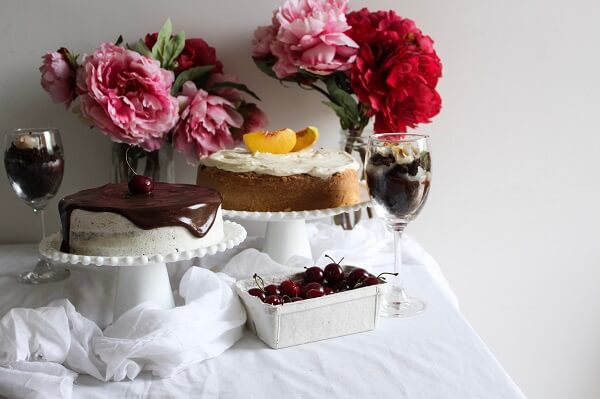Chocolate ganache is a luscious, versatile mixture that can transform any dessert into a masterpiece. Made from just two primary ingredients—chocolate and cream—it’s perfect for cake fillings, frostings, truffles, and glazes. This ultimate guide will walk you through the steps of making milk, dark, and white chocolate ganache, along with tips on how to use each type for different effects.
WHAT IS GANACHE?
Ganache is a rich, silky blend of chocolate and heavy cream. Its texture can vary from pourable to spreadable, depending on the chocolate-to-cream ratio. This versatility makes ganache a go-to in both home baking and professional pastry making. When made correctly, ganache can be used in a variety of ways, such as frosting, glazes, whipped fillings, and even as the base for chocolate truffles.

Choosing the Right Chocolate for Ganache
The type of chocolate you choose will impact the sweetness, flavor, and texture of your ganache. Here are the main types of chocolate you can use:
DARK CHOCOLATE
Ideal for a rich, intense flavor. Choose 60-70% cocoa content for a deep, slightly bitter taste.
Best Ratio: For a glossy glaze, use a 1:1 ratio; for truffles or fillings, use a 2:1 ratio.
Tips: Dark chocolate ganache sets firmer than milk or white chocolate, making it ideal for cake glazes, drip cakes, or truffles.
Uses: Drip cakes, truffles, glazes, or as a decadent filling for layered desserts.
MILK CHOCOLATE
Sweeter and creamier than dark chocolate, with a lower cocoa percentage. Milk chocolate is great for those who prefer a sweeter ganache.
Best Ratio: Milk chocolate has a higher sugar and milk content, so aim for a 1.5:1 or 2:1 ratio to avoid a runny consistency.
Tips: Milk chocolate ganache is softer than dark chocolate ganache, giving a creamier texture. It’s great for fillings, frostings, and as a sweet glaze.
Uses: Cake filling, whipped frosting, or cupcake toppings.
WHITE CHOCOLATE
Made primarily from cocoa butter, white chocolate is very sweet and can be trickier to work with due to its high sugar and fat content.
Best Ratio: White chocolate is softer, so use a 3:1 chocolate-to-cream ratio to achieve the right consistency.
Tips: White chocolate ganache can be easily flavored or colored with food-safe dyes, making it ideal for pastel or colorful desserts.
Uses: Light glazes, whipped fillings, flavored ganache (by adding purees, extracts), or colorful drip decorations.
TYPES OF GANACHE RATIOS
The ratio of chocolate to cream is key to achieving different textures:
1:1 Ratio (Equal Parts): This is a classic ganache consistency that is pourable while warm and firm when cool. Great for glazing cakes or filling layers.
2:1 Ratio (More Chocolate): This creates a thicker ganache, perfect for firm truffles or a spreadable cake filling.
1:2 Ratio (More Cream): This makes a softer, whippable ganache, ideal for a fluffy frosting.

HOW TO MAKE A GANACHE
1.Chop the Chocolate: Chop your chocolate finely and place it in a heatproof bowl. Fine chopping helps the chocolate melt smoothly.
2.Heat the Cream: In a small saucepan, heat the cream over medium heat until it just begins to simmer. Avoid boiling.
3.Combine: Pour the hot cream over the chopped chocolate. Let it sit undisturbed for 2-3 minutes to soften the chocolate.
4.Stir: Starting in the center, gently whisk or stir until the chocolate is fully melted and the mixture is smooth and glossy.
5.Cool or Use: Depending on your use, you can pour, cool, or chill the ganache to the desired consistency.
HOW TO USE GANACHE
FROSTING
Once your ganache has cooled and thickened, you can spread it over cakes for a smooth finish. For a whipped frosting, chill the ganache until it’s thick, then whip it with a mixer until fluffy.

DRIPS
To create a stunning drip effect, pour warm, pourable ganache over a chilled cake. Let the ganache naturally drip down the sides for a polished look.
FILLINGS
Ganache works wonderfully as a cake or pastry filling. Allow the ganache to cool until it’s thick yet spreadable, then use it between cake layers or inside macarons.
TRUFFLES
Use a thick ganache ratio (2:1) for truffles. Once set, scoop and roll it into balls. Coat them with cocoa powder, powdered sugar, or dip them in tempered chocolate.
PIPING
For a pipable consistency, let the ganache cool until it holds its shape. It’s ideal for adding decorative swirls or accents to desserts.
TIPS FOR PERFECT GANACHE EVERYTIME
1.Avoid Overheating the Cream: Overheated cream can cause chocolate to seize, resulting in a grainy texture. Keep the cream at a gentle simmer.
2.Fixing Split Ganache: If your ganache separates or looks oily, you can bring it back by adding a small amount of warm milk or cream, then stirring gently to combine.
3.Experiment with Flavors: Infuse your cream with flavors like coffee, cinnamon, or mint before adding it to the chocolate. Just strain out the solid ingredients before pouring it over the chocolate.
4.Temperature Matters: For best results, let the ganache cool slightly to thicken before using it as a frosting or filling.

With just a few ingredients and techniques, ganache can add a professional touch to any dessert. Experiment with dark, milk, and white chocolate ganache to discover your favorite applications. Once you’ve mastered this versatile chocolate mixture, you’ll be able to create everything from elegant drip cakes to creamy truffles with ease. Enjoy exploring the many delicious ways you can use ganache in your kitchen!
FOR MORE INDULGENT RECIPES, YOU CAN ALSO ORDER MY NEW BOOK “CHOCOLATE” NOW.

 Hello. I'm Shivesh Bhatia, a food blogger and food stylist from Delhi, India. Welcome to Bake With Shivesh, where I'll help you create magic in your kitchens with my simple recipes.
Hello. I'm Shivesh Bhatia, a food blogger and food stylist from Delhi, India. Welcome to Bake With Shivesh, where I'll help you create magic in your kitchens with my simple recipes.
Leave a Reply